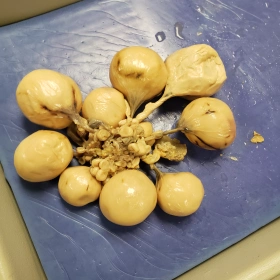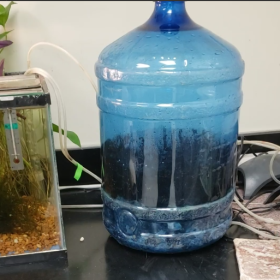
Could it be possible that the sperm/particles which fertilized the egg is/are MOSTLY from the babies’ daddy?
Darwin (1884) on pages 370-375 in volume II of his second edition of “The Variation of Animals and Plants under Domestication” implied that the “male element” with its accompanying gemmules can “act on the female tissue and influence future progeny.” This effect is anticipated before direct fertilization. The idea of telegony in heredity is this very essence: that male sperm in the body of the female (or pollen in the case of a plant), prior to fertilization can influence the genetics of the actual fertilized ovum.
Gemmules were the proposed particles of the Pangenesis hypothesis of Darwin as described in his book: “Animals and Plants under Domestication,” in Chapter 27 of his 2nd edition, Vol. 2. Current proposed particle identities have been suggested by Liu (2008). Please download the full research article and not simply the abstract to get the full scope of the possible potential particles which might act as Darwin’s “gemmules.”
Your thoughts?
Other resources (deepen your understanding of the topic):
Epigenetics: Overkalix study findings
Reflections and additional content below:
“Baby Daddy blog” reflection on 2-8-2019: ( I am now officially referring to this blog as the “Baby Daddy blog.”)
I have been thinking over the past few days about Darwin’s gemmules from his Pangenesis theory and how he suggested that they could reproduce and lodge in the female reproductive (ovaries). In my mind, I have to remember that Darwin was describing things and phenomena which had not been properly named (or at least had not acquired a universally accepted name). In my mind, the best match I can imagine is some particle that acts like a virus. So for now, I am suggesting that the identity of his gemmule happened to be a virus. At this point, I do not know enough about prions to introduce them into the discussion.
So if these gemmules were introduced by prior partners of a woman before her fertilization, a virus could be described as this “gemmule” thing that could reproduce at once in her body and then “lodge” or genetically modify her genome. Sounds like a virus.
Next thought; rather a dark one. Could the gemmules Darwin was speaking of be viruses which could efficiently be “vectored” into the woman via a sexually transmitted infection, such as human papillomavirus? What better than a highly infectious agent to introduce and change the genome?
Next question is how much does it change the woman’s genome? It is enough to contribute to different traits in the baby created by a later fertilizing “baby daddy?”
My understanding is that when an infectious virus replicates in the body of the donor, it takes on some of the cell membrane and possibly hijacks DNA from the host (via genetic linkage?); maybe little pieces that could then be inserted into the recipient DNA. So, if my thinking is correct, any virus we receive could in fact contribute to the amount of junk DNA within our own DNA.
To me, junk DNA from a virus (oncovirus) can form an oncogene that could lead to cancer. In my mind, all of this begins to rationalize the practice of retaining one faithful reproductive partner for a lifetime with the side benefit of having less junked-up DNA which could be passed on to the babies.
This also brings me back to one of my original questions in this reflection: If junk DNA from a “giver” of the virus is possibly spliced along with the viral DNA, would it, could it ever be enough in quantity to actually influence a trait of the baby created by a later fertilization to the point that it would resemble traits produced by DNA from a prior “donor” which did not result in fertilization at that time?
OK, geneticists and infectious disease experts, I need your collaboration. Are any of the ideas in this reflection plausible? Thank you in advance for your consideration.
7/2/2020 Reflection
Considering the highly infective nature of the COVID-19 virus, could “relations” with an infected individual serve as an ” RNA transmission moment?”
The corona wiki article indicated that genetic recombination can occur when more that one “viral genome” is present.
3/9/2023 update
In response to discussion with a colleague today, I searched for “epigenetic influence and fertilization” today and this article popped up immediately:
Sperm epigenetics and influence of environmental factors
If one moves to “Concluding remarks,” in the paper cited above, the indication is that seminal fluid can affect the fetal environment at the time of fertilization, specifically hormone levels. Later in the Concluding remarks, the observation is also made that epigenetic influence on the sperm can occur while in while in the female genital tract.
The question by me in this case would be that if the semen from one male was mixed with semen from another male within the female genital tract, could the sperm from one male then be affected and influenced by semen from the other?









I’m just spitballing here. But if telogomy exists in mammals (humans) a likely route would be through the rather large amount of micro RNA that sperm cells carry. If they can alter a woman’s gene expression by way of epigenetics (if lecithins can, it doesn’t seem a stretch). The foreign Micro RNA could alter the gene expression of the woman’s child.
This would be non-mendelian, and wouldn’t change the actual DNA of the offspring, but it would affect the way the DNA was expressed.
For instance, we know that drinking habits can influence an offspring’s vulnerability to alcoholism. Perhaps if this hypothetical women had been exposed to the sperm of an drunkard, the boozer expression could linger regardless of the sobriety of the mother or father.
So by this hypothesis, the mother’s genetic influence would be item getting crowded. But her DNA contribution would be the same…I think.
Epigenetics are probably being oversold right now, and i am the furthest thing from an expert. But It’s interesting to think about. And we could probably promote condom usage if we started telling people this.;)
LikeLike
This totally seems unreal and crazy. I’ll be looking more into this because it is so interesting.
LikeLike
It is not fact, but ideas.
LikeLike
That’s crazy!!! This is actually going on today.
LikeLike
We are thinking about “what if’s?”
LikeLike
Here is a link to an article on the Amazonian tribe that believed in the idea of multiple paternity.
https://www.sciencedaily.com/releases/2010/11/101110161930.htm
It’s insane to imagine that as much as we know about genetics, in the grand scheme of things, we have an infinitesimally small grasp of it all.
LikeLike
Interesting! Will check it out!
LikeLike
When I read this article, to me, It doesn’t make any sense. http://www.insider.com/woman-has-chinese-twins-different-fathers-2019-3
But now I want to do more research on this topic.
LikeLike
Ok!
LikeLike
This appears to be two different fertilization from two different dads. A different topic.
LikeLike
This is hard to believe, but explains a lot!
LikeLike
It is an hypothesis.
LikeLike
How would this affect a parent’a Ability to be a donor if their child was going through something tragic, would this minimize their chances or is it such a minimal amount that the child’s biological father would still be a possible match.
LikeLike
Already commented once but back again for the extra credit! This is very interesting but a little creepy.
LikeLike
Already commented once but find this so interesting. Back for the extra credit 👍
LikeLike
So how would that affect if they needed a parent donor for some type of tragic thing that occurs with your child(?) Is it such a minimal amount that the person you know to be the biological father would still have more than enough genetic make-up to be a good match? This blows my mind!
LikeLike
This is hypothetical. Considering possibilities, for now.
LikeLike
Already commented once and found this interesting. Back again for the extra credit 👍
LikeLike
Agreed
LikeLike
This is very interesting. Almost seems science fiction in a way. Makes me want to do more research on this topic.
LikeLike
Likewise
LikeLike
Could this be possible for the male as well?
LikeLike
Good question! Could the spermatogonia of the male be influenced by the gemmules of a partner to even make his sperm a blend of his DNA and DNA from prior partners?
LikeLike
While it is an interesting and science-backed theory, I can’t get on board with it! A little mind-blowing this could even be possible.
LikeLike
This is so weird, but fascinating! I never would have thought of this. Now I am wanting to do more research!
LikeLike
Based upon what I’ve read and my own personal education on the topic, it is possible that HPV could be a large factor in supporting the idea of telegony. Since it does take on some of the genetic make up of normal cells, it could be possible that the HPV virus could pick up genetic material from the female egg and therefore give a child characteristics of the previous lover (if he gave her HPV) even though the child is not his. A definite possible thought
LikeLike
Interesting!
LikeLike
Interesting and pretty crazy information!
LikeLike
Agreed!
LikeLike
This is so weird! It is very interesting what can take place in the human body to potentially change the DNA of the female causing the baby to not completely look like the biological father.
LikeLike
Hello.
LikeLike
I’m no expert but but this seems very interesting and seems possible. When you break it down like that, it seems since it does become part of the woman’s junk DNA then that is our DNA and our child could possibly receive some of those trace amounts as well. Thanks for making us think…
LikeLike
Crazy and wiierrrdd!
LikeLike
This is very interesting and it’s crazy to think about all the factors that can take place.
LikeLike
Noticing that you asked for experts opinions, I am not sure what makes me an eligible person to respond, but I’ll wing it anyway.
I did not expect this blog to take that turn. The idea of the host DNA transferring is interesting and logical. I do believe there is a high probability of enough DNA affecting the baby’s genetics, BUT only if this happens before the fertilized egg has been fully formed.
LikeLike
So, this is what I’m getting from this, Darwin’s theory of Pangenesis is basically that the traits of one previous male partner could affect the genes of the offspring between the same female and a new male partner. He suggests that gemules, which are free, floating particles would enter the when the two engaged sexually, could change the traits given to have some influence over the genes of the offspring despite not being the male who mated the off-spring had been conceived by. It’s common knowledge that sperm cannot live in the female body for more than a week and we also know that CNA, which in circulating nucleic acids (DNA and RNA), are found to be free, floating particles and are thought to be from the breakdown of cells that have died.1 So, with that information, sperm from Male A is transferred into Female A and they make their journey through the uterus and into the fallopian tubes, it’s possible that the as the sperm begin to die off they release their nucleic acids which could then enter and change some of the sex cells in Female A’s body and make changes to the molecular structure of the DNA in the new host cell; therefore, it could change the genetic make-up and becoming part of the female’s cells. When Female A interacts with Male B and becomes ‘fertilized’ the influenced cells in her body are combined with Male B’s sperm and with that Male A did have an influence over the genetic material of the off-spring from Female A and Male B.
1 http://cna.gene-quantification.info
LikeLiked by 1 person
Wow! Nicely put. I added a bit to my original post hypothesizing that a viral vector, such as a sexually transmitted infection could be the vehicle of “change.”
LikeLiked by 2 people
I just noticed your CNA article suggested HPV (human papillomavirus) which I had written in my reflection in the original post without knowledge of the information at this site. Coincidence?!
LikeLike
I really like the way you broke this down, it was really easy to follow and understand – it’s all really interesting!
LikeLike
Agreed!
LikeLike
amazing. never even thought about it that way, especially with the CNA.
#barnesissh00k
LikeLike
So what if the person has been vaccinated for the HPV virus is CNA still possible
LikeLike
Good question.
LikeLike
This break down makes more sense to me now, but it’s still crazy to think about.
LikeLike
Yes, I get that.
LikeLike
i think it’s a pretty solid response with some good facts.
LikeLike
This seems plausible. The conditions of the first males healthy seminal fluid could very well affect the condition of the baby in the woman. It has been seen before that cancerous genes will change dna for the worse and destroy DNA.
LikeLike
Through what little research I’ve done, it seems that the idea of Pangenesis in humans is implausible. In the late 1800s, German biologist August Weismann introduced Germ Plasm Theory which states that germ cells (sperm and eggs) are the only cells that have any influence on the genetics of offspring. This is often named the “Weismann barrier”. That being said, I can see how maybe heredity could work differently in other organisms such as the flies in Liu’s experiment.
LikeLike
Possible that something like this might work on a lower animal, but not a higher one, such as humans. Mouse model testing would be nice.
LikeLike
Interesting
LikeLike
What an interesting concept! I didn’t even know about CNA until you mentioned it!
LikeLike
So what does this mean for the rest of the future? Does it mean people are walking around and probably do not know who their father is? Well these cases are very rare and can happen in extreme circumstances.
LikeLike
This definitely blows the lid off Maury!
A lot of people believe in abstaining from sex until marriage. Could there be some connection within this genetic theory of telegony that would also involve some historic mindframe of creating a “purer” bloodline of sorts by solely mating with one chosen partner and thus only transferring traits from one source? Weird stuff, man.
LikeLike
This is consistent with some of the ideas in the telegony Wiki……
LikeLike
Amen bruther
LikeLike
I think this is likely because of the gemmules staying around and affecting the offspring, in short term, but I don’t think this could happen as a long term possibility. I think it would have to happen in the same period.
LikeLike
Seems reasonable.
LikeLike
The suggestion is that the “gemmules” can multiply (Darwin) and concentrate in the female parts, thus influencing the chromosomal material of the unfertilized eggs.
LikeLike
I have witnessed the rare act of a female having twins and they have different fathers. This is interesting because the idea of not haveing one definite father and mother is scary. So am I my dad and my moms past lovers? Could explain why im nothing like her lol.!
LikeLike
Comment from Charee, Vincent, Tamera, Matt
Our theory on this article concludes that if a heterozygous couple has sexual relations at one time then the female goes and have those same relations with a different male, assuming she got pregnant, then the baby would possibly look like the first male she had sexual relations with.
LikeLike
We have never heard of such a thing, very interesting?
LikeLike
This is very interesting and I wonder what other people think about this topic. I’ve never really thought about, but it’s something to think about.
LikeLike
Interesting
LikeLike
Naturally, this doesn’t make sense. Darwinism as a definition is survival of the fittest thousands of sperm fight to impregnate only one egg
LikeLike
If a woman has multiple partners, but she has one father to her child, then it’s not possible that the other partners have passed on traits to that sperm. If a woman uses the proper protection (birth control, Plan B, etc.) then those methods are designed to eliminate, or block, the sperm from passing through to the egg.
LikeLike
Yes if a woman is ovulating then it could be possible the day she did it with two males that she conceived two different kids by both .
LikeLike
Fraternal twins…
LikeLiked by 1 person
So as a group we all believe that, while a group of sperm attempt to penetrate the egg, typically only one will get through and be able to fertilize. However, one sperm might be able to influence the others which could cause the differences between offspring.
LikeLike
Interesting.
LikeLike
While this concept may be possible for other species, we say us humans are much more complex for this to work. The main problem with this is the time between the initial sperm cell reaching the egg and the sperm cell that actually triggers the pregnancy. The first cell would probably be dead by then.
LikeLike
Darwin does even talk about regeneration occurring more readily in simpler organisms.
LikeLike
Interesting! We are definitely more complex as humans, and it makes sense this would occur more commonly in lesser organisms.
LikeLike
It might be possible if a woman had more than one partner in a one or two day period while she is ovulating. Because after a few days the sperm is no longer viable. You could also find out if this is possible by taking the DNA of each of the mothers partners and putting it up against the child’s DNA.
LikeLike
I think that the suspicion as that the “gemmule” particles are in addition to the DNA. Like tiny.
LikeLike
I dont think it is possible for this to happen two men cannot have the same kid
LikeLike
Please check out the previous links posted in this strand regarding this very issue.
LikeLike
I don’t think this is possible. The female should only mate with one male. So there should not be a problem with another males sperm.
LikeLike
There is a way for sperm go pick up other dead sperm in the female body but once it’s been around five days then the sperm wouldn’t have any dna to transfer. So even if something picked it up the dna would already be dead for it.
LikeLike
The gemmules, as I understand from Darwin, could multiply and become more numerous and also concentrate in the “maternal tissues.”
LikeLike
While many scientists say this is possible, I haven’t seen much evidence that this can be done naturally. Articles I’ve seen entertaining this interesting thought only say it’s possible in a lab-controlled environment.
Couple of articles on the subject:
https://www.newscientist.com/article/2105697-heres-why-two-dad-babies-arent-yet-a-biological-reality/
https://www.sbs.com.au/topics/science/humans/article/2016/07/13/children-two-genetic-fathers-its-possible
LikeLike
Wow! The articles stretch the mind.
LikeLike
“Multiplex parenting,” in the second article……
LikeLike
This is very interesting and transforms the way of thinking
LikeLike
Interesting addition
LikeLike
I find it kind of strange and interesting because two guys can be the father of one single baby.
LikeLike
I disagree.
LikeLike
I do not think that is possible. Two men can not be the same child’s father, does not seem logical at all.
LikeLike
I believe one egg is fertilized by one sperm. And there should not be multiple men’s sperm inside the mother.
LikeLike
No
LikeLike
No. This is impossible. There is no way sperm can or would pick up other genetic material. One, they have no need to pick up another set of genes they already have. Two, any sperm left inside the vagina that has no impregnated the egg would be dead.
LikeLike
Darwin indicates in his theory that the gemmules can multiply and become more numerous.
LikeLike
I think it is possible to have a little bit of genes from another sperm cell. the fact that multiple eggs can be fertilized by multiple sperms could make for fraternal twins of different “daddies.”
LikeLike
Fraternal = two separate sperms fertilizing two separate eggs.
LikeLike
There have been few cases that this has happened, but it has happened. there was a mother who had intercourse with her husband and another guy while she was ovulating and ended up with Identical twins but they have two different dads. So it is possible, but it is very rare.
LikeLike
I have read this as well, so as the article prompts, yes it is possible, but no it’s not likely. The chances of this happening in humans is incredibly low. However, I do find it more possible in plants due to how much pollination is moved from flower to flower at once.
LikeLike
I think this was two separate sperms fertilizing two separate eggs.
LikeLike
that’s cool.
LikeLike
That’s really weird.
LikeLike
Is there a source for this? When did this happen?
LikeLike
See my reply above….
LikeLike
If a DNA test was taken from partner A and B of the woman and there was percentages from both partners, that would be the way to find out.
LikeLike
Possibly. The particles being discussed may be “extra” to the DNA.
LikeLike
I’m just wondering what the timeline is from each partner and when the sperm would die.
This is a good point though, and an interesting concept as a whole.
LikeLike
Darwin said that the gemmules are affected by old age. He also indicated that the gemmules could multiply, especially once in the female (ovule/ovary). That is what I get from the reading in “Variations. ”
I am attempting to pair these writings from the 1890’s to current-day lingo. The gemmules could be prions or smaller, unnamed particles. Another suggestion is that the particles are micro/small RNA particles. I am saying this from memory at this time.
The survival of the sperm and time between contact (s) would be irrelevant if the particles had the ability to reproduce and concentrate while in the process of organismal modification or some kind of latency.
This is mostly theoretical proposal-stuff.
LikeLike
The “lingo” I was quoting was from the Liu (2008) paper referenced in the blog.
LikeLike
Did you ever hear the tragedy of Darth Plagueis The Wise? I thought not. It’s not a story the Jedi would tell you. It’s a Sith legend. Darth Plagueis was a Dark Lord of the Sith, so powerful and so wise he could use the Force to influence the midichlorians to create life… He had such a knowledge of the dark side that he could even keep the ones he cared about from dying. The dark side of the Force is a pathway to many abilities some consider to be unnatural. He became so powerful… the only thing he was afraid of was losing his power, which eventually, of course, he did. Unfortunately, he taught his apprentice everything he knew, then his apprentice killed him in his sleep. Ironic. He could save others from death, but not himself.
LikeLike
This is not the place for memes man.
LikeLike
Its treason then
LikeLike
Hello there!
LikeLike
General Kenobi!
You are a bold one.
LikeLike
I agree that it is definitely difficult to have too much Star Wars lore in one’s life…..however, D.P., please relate your story more closely to the gemmule investigation. Are you relating midichlorians to gemmules?
LikeLike
I think in some species this could be possible, such as plants with the transferring of pollen from multiple plants. However, I do not believe having more than two parents is scientifically possible with mammals. I believe that once the DNA in the sperm has died than it can not be reactivated.
LikeLiked by 1 person
Yes I agree
LikeLike
Outside sources are able to influence and maybe even change the human genome. Such as smoking will change your genome to be more susceptible to lung cancer or COPD which can be passed down to offspring. So prior sexual partners could definitely influence an offspring altogether, even if it’s not what it looks like, rather the things it more susceptible to getting and dealing with as far as diseases and health issues.
LikeLike
Epigenetics…..
LikeLike
Seems like we have some daddy issues here. It is fascinating that our children or even us can potientaly be not 100 percent of our genes.
LikeLike
do you already have kids/a kid?
LikeLike
Yes, interesting.
LikeLike
Totally agree with this!
LikeLike